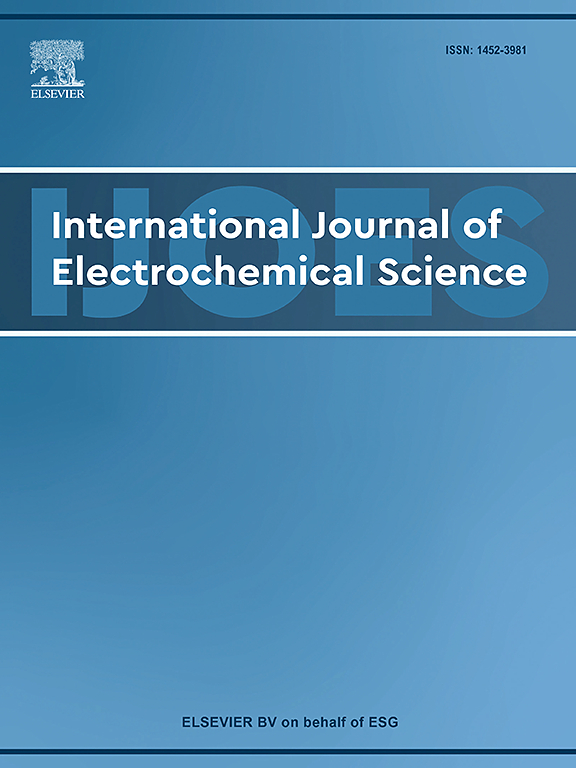A comprehensive review of electrochemical lactate biosensors: Principles, innovations, and future perspectives
IF 2.4
4区 化学
Q4 ELECTROCHEMISTRY
International Journal of Electrochemical Science
Pub Date : 2025-07-22
DOI:10.1016/j.ijoes.2025.101132
引用次数: 0
Abstract
Lactate, a pivotal metabolite in cellular energetics, has garnered significant attention as a biomarker for assessing physiological status in sports science and clinical diagnostics. The limitations of traditional invasive lactate measurement methods have spurred the development of electrochemical biosensors, offering pathways for real-time, non-invasive, and continuous monitoring. This review provides a comprehensive overview of the progress in electrochemical lactate biosensors, with a particular focus on their application in enhancing sports science and performance monitoring. Fundamental principles, including amperometric, voltammetric, and potentiometric detection, alongside the roles of lactate oxidase and lactate dehydrogenase, are discussed. Recent advancements highlight the transformative impact of nanomaterials such as graphene, carbon nanotubes, metal/metal oxide nanoparticles, and MXenes in improving sensor sensitivity, stability, and selectivity. Innovations in fabrication techniques, including screen printing, 3D printing, and microfluidics, are paving the way for sophisticated wearable devices targeting sweat, saliva, and interstitial fluid. The application of these biosensors in sports for determining lactate thresholds, monitoring exercise intensity, managing fatigue, and optimizing training is critically examined. Despite significant strides, challenges related to analytical performance, biofluid correlation with blood, sensor-body interface, and data interpretation persist. Future directions point towards multiplexed sensing, integration with the Internet of Things (IoT), and the application of artificial intelligence and machine learning for advanced data analytics, heralding an era of personalized and data-driven athletic training and healthcare.
电化学乳酸生物传感器的综述:原理、创新和未来展望
乳酸是细胞能量学中的关键代谢物,作为评估运动科学和临床诊断中生理状态的生物标志物,已引起了人们的极大关注。传统侵入式乳酸测量方法的局限性刺激了电化学生物传感器的发展,为实时、非侵入性和连续监测提供了途径。本文综述了电化学乳酸生物传感器的研究进展,重点介绍了电化学乳酸生物传感器在提高运动科学和运动成绩监测方面的应用。基本原理,包括安培,伏安和电位检测,以及乳酸氧化酶和乳酸脱氢酶的作用,进行了讨论。最近的进展突出了石墨烯、碳纳米管、金属/金属氧化物纳米颗粒和MXenes等纳米材料在提高传感器灵敏度、稳定性和选择性方面的变革性影响。制造技术的创新,包括丝网印刷、3D打印和微流体,正在为针对汗液、唾液和组织液的复杂可穿戴设备铺平道路。这些生物传感器在运动中用于确定乳酸阈值、监测运动强度、管理疲劳和优化训练的应用被严格审查。尽管取得了重大进展,但与分析性能、与血液的生物流体相关性、传感器身体接口和数据解释相关的挑战仍然存在。未来的方向是多路传感,与物联网(IoT)的集成,以及人工智能和机器学习在高级数据分析中的应用,预示着个性化和数据驱动的运动训练和医疗保健时代的到来。
本文章由计算机程序翻译,如有差异,请以英文原文为准。
求助全文
约1分钟内获得全文
求助全文
来源期刊
CiteScore
3.00
自引率
20.00%
发文量
714
审稿时长
2.6 months
期刊介绍:
International Journal of Electrochemical Science is a peer-reviewed, open access journal that publishes original research articles, short communications as well as review articles in all areas of electrochemistry: Scope - Theoretical and Computational Electrochemistry - Processes on Electrodes - Electroanalytical Chemistry and Sensor Science - Corrosion - Electrochemical Energy Conversion and Storage - Electrochemical Engineering - Coatings - Electrochemical Synthesis - Bioelectrochemistry - Molecular Electrochemistry

 求助内容:
求助内容: 应助结果提醒方式:
应助结果提醒方式:


